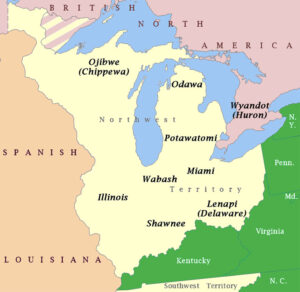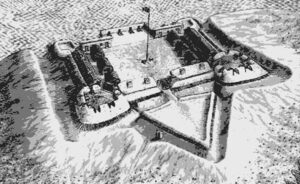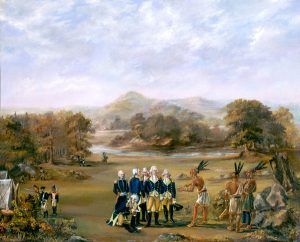Fort Miami was a British fort built in the spring of 1794 on the west side of the Maumee River in the Old Northwest Territory.
Before Fort Miami was built, the site was used as a French trading post in the 1600s. An archeology study revealed that the Late Woodland mound builders also used it.
Under the Treaty of Paris in 1783, which ended the American Revolutionary War, the region south of the Great Lakes and between the Ohio and Mississippi Rivers was assigned to the United States. The British, however, refused to evacuate their troops from their forts in the region, claiming that the U.S. had not complied with portions of the treaty. This included pre-Revolution debts owed to British merchants and subjects that had not been paid.
In the early 1790s, the Lieutenant Governor of Upper Canada, John Graves Simcoe, made an aggressive effort to aid the “Northwestern Confederacy” of Native American tribes, including the Shawnee, Miami, Wyandot, and others, in their ongoing war with American settlers. His ultimate goal was the establishment of an Indian barrier state in the region as a way to protect Britain’s North American fur trade ventures and to block anticipated American attacks upon their remaining North American possessions.
In the spring of 1794, the British built Fort Miami to forestall U.S. General Anthony Wayne’s advance on Britain’s Fort Detroit and to encourage the Confederate tribes in their war of resistance. The fort consisted of a log stockade with four diamond-shaped earthen bastions, each capable of mounting four cannons, a river battery, barracks, officers’ quarters, supply buildings, and various shops. A 20- to 25-foot-deep defensive ditch ran along the fort’s landside, lined with rows of stakes.
In July 1794, General Wayne and his troops marched northward toward Fort Miami from Fort Recovery. Encountering a barricade erected by the Native Americans and a small party of Canadian militia just south of Fort Miami, he ordered a charge. In August 1794, Major William Campbell and approximately 200 British soldiers took command of Fort Miami.
On August 20, 1794, General Wayne dispersed his adversaries in the Battle of Fallen Timbers. The Native Americans fled to the fort, but the commander shut them out. It was the final battle of the Northwest Indian War, a struggle between Native American tribes affiliated with the Northwestern Confederacy and their British allies against the United States for control of the Northwest Territory. The battle occurred near the Maumee River at the site of the present-day city of Maumee, Ohio.
Beaten and disillusioned, the Native Americans dispersed, and one year later, their tribal elders gathered at Fort Greenville to negotiate with General Wayne. The Treaty of Greenville opened most of the present State of Ohio and part of Indiana to United States settlement. In 1796, under the Jay Treaty of 1794 terms, the British abandoned Fort Miami and their other forts on American soil. General Wayne then occupied and garrisoned it, but in about 1799, it was abandoned.
The British and Shawnee Chief Tecumseh occupied the ruined fort and its dock facilities during the War of 1812. Although the fort was not rebuilt, the area served as headquarters and a staging area for the siege against General William Henry Harrison at Fort Meigs, just southeast and on the other side of the Maumee River. In an action associated with that siege, British and Indian forces from Fort Miami counterattacked and destroyed an American force attempting a siege on the British gun batteries. U.S. prisoners captured in this action were forced to run a gauntlet into the ruins of the fort, resulting in several prisoners being killed in an incident known as Dudley’s Massacre. Shawnee leader Tecumseh arrived at the fort during this massacre. Fearing retribution from the Americans, he convinced the warriors to stop the killing, thus saving the rest of the captive troops. The failure of the siege of Fort Meigs marked the end of the military use of the Fort Miami site.
Abandoned again in 1814, the fort was eventually demolished. Afterward, the site reverted to agricultural and public park use.
Fort Miami is listed in the National Register of Historic Places as a historic site and is significant for its association with the Battle of Fallen Timbers in 1794.
The site is part of the Fallen Timbers Battlefield and Fort Miami National Historic Site at the eastern edge of present-day Maumee, Ohio, southwest of Toledo. Only some of the trenches, traces of the earthen walls, and one of the bastions remain visible.
© Kathy Alexander/Legends of America, updated August 2024.
Also See:
Old Northwest War Military Campaign
Sources:





